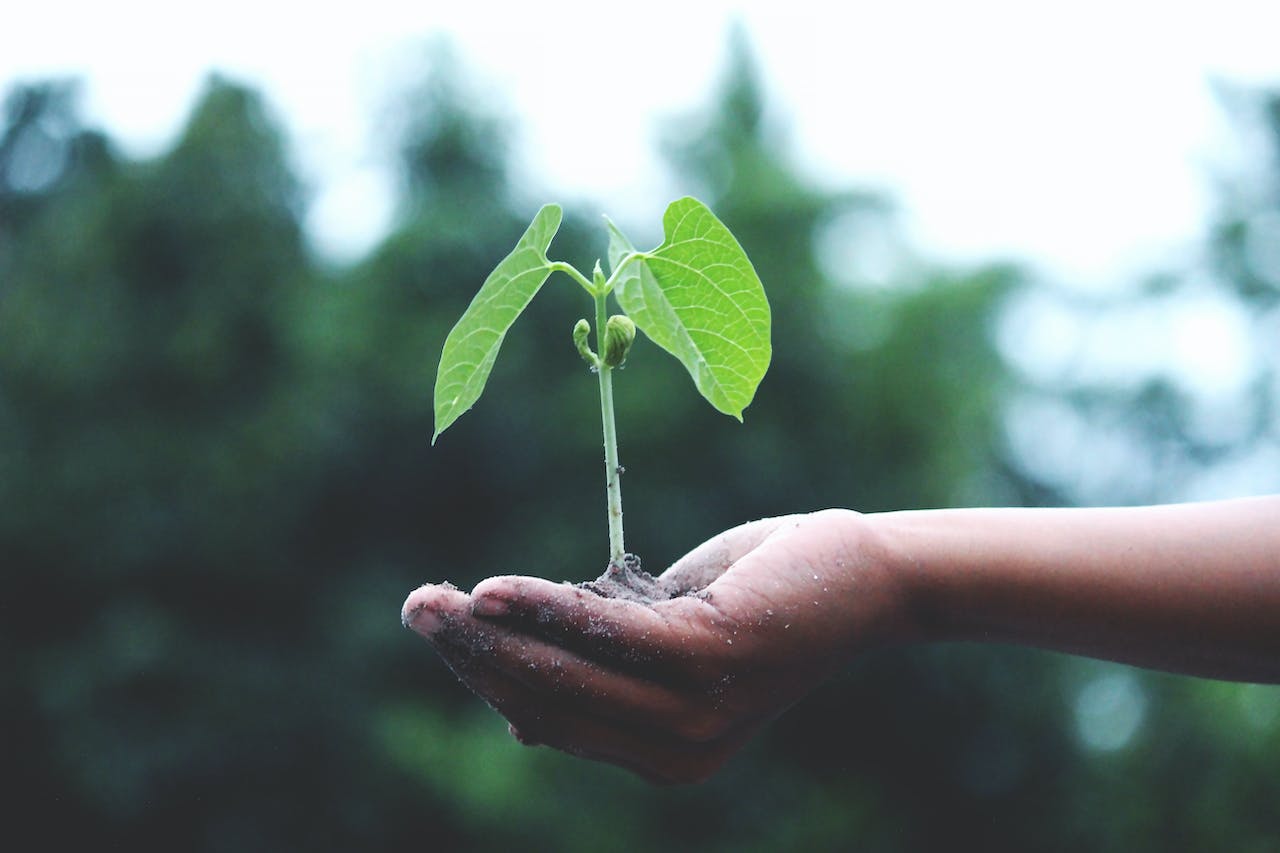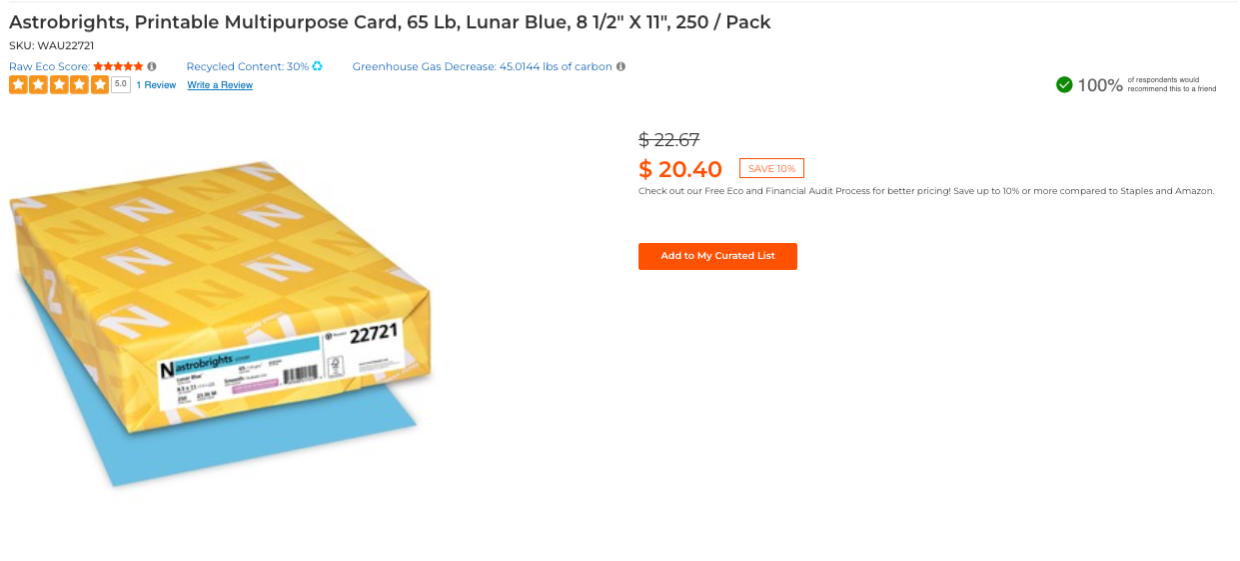Sustainable Purchasing
How The Raw Office Enables Eco-Forward Product Education, Transparency and Increased Sustainable Purchasing by Customers
Overall, The Raw Office’s platform provides customers with access to a wide selection of eco products for their businesses, while providing them with an average 20% financial savings and 50% time savings. Since 2016, The Raw Office clients have experienced a 90% decrease in ordering mistakes and been able to increase the recycled content of their purchasing by 229% recycled content.

Raw Eco
Score
We developed an extensive and comprehensive scoring system to ensure that all of the products on The Raw Office are eco forward. The RAW ECO SCORE helps customers pick products that adhere to high standards, which allows customers to buy with full transparency.
We only select products manufactured with a minimum of fifty percent-recycled materials or agricultural fibers - except for inks, toner, soaps, and sanitizers, of course. These get a pass on our recycled content baseline as they are business must-haves and fit some of our other criteria for ranking: such as reduced packaging, non-toxic and natural ingredients, or local production.
AI for Green Purchasing
We use Artificial Intelligence to asssess new and prospective customer company’s previous purchases and supply needs.
We help customers to consider both identical and green product options at discounted rates to help them make more informed purchasing choices. After reviewing the potential financial savings and benefits of switching to a more eco-friendly product option, customers can easily place orders and reorders from through a pre-populated individually curated program.
Carbon Neutral Products
The Raw Office offsets 100% of greenhouse gas emissions related to products at no extra charge. This allows customers to contribute to climate action and advance their company's sustainability objectives through their purchases.
Our supply chain is meticulously designed to be carbon-neutral to maximize commitment to environmental stewardship.
Our Eco-Conscious Evaluation System
Rigorous assessment of the sustainability and ethics of our supply sources.
Prioritizing products made with recycled and environmentally friendly materials.
Evaluating the environmental impact of production methods used by our suppliers.
Championing products that reduce energy consumption to contribute to a more sustainable business model
Ensuring fair labor practices and supporting North American manufacturers.
Selecting products that are not only effective but also safe for both users and the environment.
Join Our Commitment to Positive Change

Where do we see the GreenHouse Gas Emissions?
The Raw Office customers with an account and curated favorites can now view the greenhouse gas emissions for all their purchased products. Each product page on the The Raw Office website displays the pounds of greenhouse gas produced, indicating the offset upon purchase.

Emissions Calculations
The emissions calculations we are using take into account the emissions from raw materials, processing, production, intermediate shipping, packaging and delivery to your doorstep. Our life cycle assessments have covered the greenhouse gas emissions from a product’s “cradle,” to the “gate,” or a “Cradle-to- gate” scope of calculation.

The Green House Gas Carbon Emissions for this product is 45.0144 pounds and is comprised of 3.54% shipping, 14.60% packaging, 21.05% materials & 60.82% manufacturing.
What is the methodology?
To achieve this, we collaborated with Carbon Credit Capital to gather data on each product we offer. Our analysis covers emissions from raw material stages, processing into intermediate products, manufacturing finished goods, and shipping emissions.
If you are interested to learn more, you can find a list of our assumptions made to make the calculations that make this all possible below:
Emissions from inbound raw materials procurement is the average emissions from all products’ point of manufacture to port of destination trucking emissions, and is applied to all products universal
Point of origin for products is designated as capital of origin country, or most well known manufacturing hub within origin country
Port of origin is designated as the nearest international port to the origin city
Mode of transportation from city to port of origin is designated as by truck
Port of destination is designated as one of three potential
Code of Conduct
Our Code of Conduct sets ethical standards and behaviour expectations, promoting integrity, respect, and accountability among all members of our organization.
Suppliers shall not use forced labor, whether in the form of prison labor, indentured labor, bonded labor, or otherwise. Suppliers must allow employees to keep their own identification documents and to resign from their positions at any time.
Suppliers shall not employ people younger than 15, or the minimum age for the completion of compulsory education, or the minimum age of employment required by law in the country of manufacture, whichever is highest.
Suppliers shall treat every employee with respect and dignity, and shall not subject any employee to physical, sexual, psychological, or verbal harassment or abuse.
Suppliers shall not subject any person to discrimination in employment (including hiring, salary benefits, advancement, discipline, termination, or retirement) on the basis of gender, marital status, race, religion, age, disability, sexual orientation, nationality, political opinion, social or ethnic origin or any other condition that could give rise to discrimination.
Suppliers shall provide a safe and healthy environment to prevent accidents and injury to health from occurring and comply with applicable laws and regulations. Suppliers shall identify, assess and minimize the impact of emergency situations by implementing emergency plans and response procedures. These plans and procedures must include the following: emergency exits are accessible and fully functional at all times, fire extinguishers must be visible, accessible, present and charged, evacuation plans must be posted and drills must be conducted annually. Supplier shall identify, evaluate and control exposure to hazards and ensure the use of any applicable personal protective equipment.
Suppliers shall recognize and respect the right of employees to freedom of association and collective bargaining. Management is encouraged to engage in direct communication with employees.
Suppliers shall pay employees at least the minimum wage required by local law, or the prevailing industry wage if no minimum wage law applies, and shall provide legally mandated benefits.
Employees should not be required to work more than 60 hours a week, or the maximum number of work hours per week permitted in the applicable country of manufacture, whichever is less, except in extraordinary business circumstances. Employees should be granted at least one day off in every seven-day period. In addition to their compensation for regular hours of work, suppliers shall compensate employees for overtime hours at the applicable premium rate in their country. In countries that have not established premium overtime rates, suppliers shall not pay employees less than their regular hourly rate for overtime hours.
Suppliers are held to the highest standards of integrity. Corruption, bribery and extortion are strictly prohibited. Suppliers must respect all intellectual property rights and applicable regulatory requirements of the countries from and to which they ship.
Suppliers must meet all applicable environmental laws and regulations in their country to manage hazardous materials and all waste and emissions materials. In addition, Suppliers are encouraged to have environmental policies, and environmental management systems containing goals with targets that are focused on the continuous improvement of overall environmental performance.
We do not do any testing on animals. We also encourage all of the manufacturers and distributors that we feature on the The Raw Office website to also not do any animal testing and to treat all animals in a cruelty free humane way.
All The Raw Office internal staff & contracted team members (Staff & Contractors) must use best efforts to minimize and eliminate The Raw Office related waste going to landfill and pollution going into the water stream and atmosphere. To accomplish this, all Staff & Contractors must set up and utilize recycling, composting and e-waste bins at all company and home office and business locations. Staff & Contractors shall use best efforts to operate with a paperless business utilizing cloud and Saas technologies instead.




